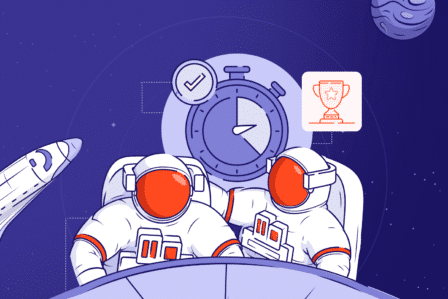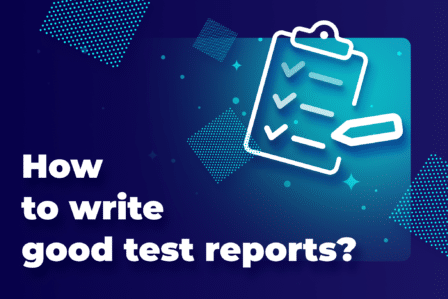How we improved the frequency of time registration in the time tracker app

Remote work has become a standard for development teams. For this reason, their leaders have to deal with numerous challenges to keep project management efficient. The most common problems usually concern communication issues, reliable project planning, the integrity of teams, and work time tracking. In this article, we will share how we improved the frequency of time registration with a time tracker app. Read on to find out!
Why is time tracking so important?
Tracking the progress of specific tasks is crucial in many aspects of project management. Contrary to popular belief, it’s not about controlling team members and making sure they really work from 9 to 5, for 8 hours straight. Of course, managers need to know which tasks occupy their teams and for how long. Nevertheless, time tracking serves much more than just counting salary at the end of the month. The awareness of how much time teams have spent on a given task or a project makes it possible to estimate the costs and duration of similar activities in the future.
The risks of neglecting time tracking
The consequences of underestimating time tracking are undoubtedly grave for the project as a whole. When we don’t log work on a regular basis, a realistic evaluation of the time spent on particular tasks becomes impossible. It’s a serious problem especially if developers work on multiple projects simultaneously. From the time perspective, the team members can’t indicate precisely how many hours they spent on each activity. This is not something that we should overlook as even the smallest imprecision can make the project costs improperly estimated.
This affects the collaboration between customers and providers of IT services as both sides need to calculate the profitability of the final product. All numbers should be accurate in order to be reliable. Knowing the profitability before the actual work starts allows for determining if everything goes as planned at each stage of development. If it doesn’t, the stakeholders can implement necessary modifications on time, avoid exceeding the client’s budget, renegotiate the contract terms, or even cancel the project.
Tempo for Jira – a time tracker app for employees
When a company uses Atlassian’s Jira for project management, there’s no better and more popular app for time tracking than Tempo Timesheets – Jira Time Tracking. It’s available on the Atlassian Marketplace and works on every hosting: Cloud, Server, and Data Center. The app seamlessly integrates with Jira and lets the team members intuitively register time spent on every task. Tempo doesn’t require long initial training, even the newcomers quickly figure out the most important features. For these reasons, the extension is used by over 20,000 companies and has been considered the #1 time management product in the Atlassian ecosystem since 2010.
Even the greatest app won’t bring the expected results if we don’t use it properly. Unfortunately, regular time registration is an issue, particularly amongst developers. They often associate it with being controlled or just don’t consider it necessary. This problem leads to hiring a dedicated person to remind people to register their working hours. It generates additional project costs which is the last thing managers and customers want to hear about during development. What’s more, constant going on about time tracking isn’t pleasant for the project managers, who would rather invest their time in other activities, or for the developers themselves.
Some time ago, we thought about another way to encourage our teams to register time more frequently. Whilst evaluating the potential of our new gamification app for Jira, we conducted an experiment. In our case, it turned out to be successful, especially when it comes to time logs.
Discover Atlassian Services
Learn more about our services
and use Deviniti’s experience.
[Case Study] How did we manage to improve time registration frequency at Deviniti?
What problems did we want to solve by the experiment?
As a nearly 300-people company, Deviniti is involved in many projects in which developers need to work on more than one task at a time. Our project managers were dealing with exactly the same challenges as described in the first paragraph of this article. Deviniti benefits from the advantages of the Tempo for Jira app, but not everyone was eager to log time regularly. Any deficiencies in worklogs resulted in less reliable data when it came to project profitability. Consistency is crucial as it’s difficult to remember what one was doing a week ago and exactly how long it took. This results in false time estimations or simply long gaps in worklogs.
Everyday time registration minimizes the risk of miscounts and makes it possible to react immediately if something comes out. When the team members forgot to register time consistently, it required asking additional questions, consultations, and comparisons with similar projects. Still, we couldn’t be 100% sure of all our countings. Of course, we didn’t want to make the development teams feel like we don’t trust them. This is the point where we came up with the idea of making tracking time fun for our employees.
The assumptions and time tracker app that we used
Test participants and success metrics
We aimed to verify the effects of implementing gamification as a support for an app for tracking work hours in two monthly iterations. There were 5 teams that took part in the experiment: 1 support team and 4 development teams. Three of them used Scrum, and the other two – the Kanban methodology. One independent person, a gamification designer, conducted the whole process and set up conditions and a rating scale. The development teams worked on multiple apps at a time by adding new features to them and counted 4-8 people. They worked in an organizational structure. Each person had a specific role and every project had a leader who was taking care of all necessary standards. On a daily basis, they also belong to one, cross-functional Scrum team, that creates a wide range of applications.
In each group, we wanted to check the influence of gamification on a chosen metric such as:
- the speed of informing customers about new releases of our apps containing features and fixes they have been waiting for,
- the percentage of tasks where the code review took no more time than 3 working days,
- the proportion of tasks where the code review time didn’t cross the estimated threshold (depending on the complexity of a given task),
- the percentage of completed story points in particular sprints,
- the frequency of work time registration in Tempo.
Our experiment has shown positive results in all of these areas. However, in this article, we will focus only on the last metric. We measured it in one of the development teams – Nova – in both iterations and only in the second iteration in the other teams. The goal was to improve time logging consistency by registering hours spent on a given task the next working day at the latest.
The apps used during the experiment
We have used Tempo Timesheets for time logging and a dedicated app for gamification features. Thanks to the app, team members could get points, badges, and ranks for their activities. Additionally, one of the teams configured Slack notifications to pop up each time a given task was getting close to reaching the time limit for code review to optimize their reaction time.
The MyBenefit motivational system
In order to make the game even more rewarding, the points gained in gamification tool were converted to MyBenefit points. The points are exchangeable for a wide range of services or products available on the MyBenefit platform. The user’s accounts were topped up with a proper amount of points once a month, at the end of each iteration. There was a dedicated fixed budget for the experiment. Metrics had their own rating scale as some goals required more complex activities and others were easier to achieve. In the case of measuring the frequency of time registration, the points were given individually to the team members who filled up their timesheets.
Individual metrics allowed to reward everyone separately, so that the results of the rest of the group couldn’t affect one’s final score. However, the friendly competition was on as the participants could be up to date with the entire team’s points thanks to a dedicated board.
The results and our conclusions
We can confirm that in our case using gamification visibly improved the frequency of logging time in Tempo for Jira. In the first iteration, the Nova team increased the percentage of working days when timesheets were updated no later than the following day from 16% to 77.5%. In the second iteration, all participating teams also proved to be motivated by gamification features as their results in the metric increased from 38% to 76% (in comparison to the same month last year).
The Trophy app turned out to be a self-sufficient gamification solution, and its support was unquestionably effective for our teams. A sense of competition and the fact that participating team members didn’t want to stay behind were the main reasons why they updated their timesheets more regularly than before. The MyBenefit points were like a cool extra prize.
It needs to be remembered that the urge to compete can be an additional stress factor for some employees. 86% of the participants considered implementing gamification positive or neutral, but the other 14% noticed a negative influence on their work environment. This is why points as a motivational system need to be introduced carefully and monitored every step of the way by an independent leader or HR specialist.
Make the most of your time tracker app
When it comes to efficient time tracking, installing an app for this purpose is usually not enough, even if it’s maximally intuitive and user-friendly. Many employees underestimate the importance of registering the time spent on specific tasks or feel controlled whilst being asked to mind it. As time tracking is without a doubt crucial for project cost estimations, companies can benefit from different kinds of help in this matter. One way of making logging time interesting is gamification which, in the case of Deviniti teams that took part in the internal experiment, turned out to be very successful. However, although getting points is fun and motivating, the leaders need to keep in mind that additional competition is not always what the team needs, and the gamification process should always be supervised.




